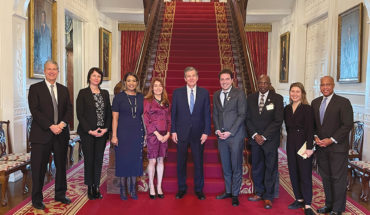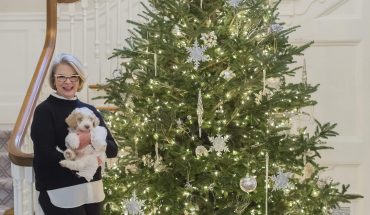by Samantha Thompson Hatem
photographs by Nick Pironio
Before you even read this, go ahead and pull out a recycling bag.
Denise Hughes asks that you kindly fill it with plastic bottle caps. All sizes and colors are welcome. And don’t stop with water bottle caps, either. Think lids to peanut butter jars, bottles of medicine, jugs of milk.
Hughes, a prolific painter best known around Raleigh for her whimsical murals at Marbles Kids Museum, will gladly take them off your hands – and out of trash cans – for her latest endeavor. She’s spent countless hours this summer hot gluing plastic caps on canvas to create colorful mosaics of marine life – from octopus to jelly fish.
Her new work is captivating and oddly beautiful. It is, after all, made from plastic pieces that were meant for the recycling bin. But it’s a making a statement, one that Hughes didn’t expect and hasn’t experienced in her nearly 20 years as an artist.
“People stop me and they say, ‘A friend of mine showed me what you’re doing with these caps, and we’ve started our collections now,’ ” says Hughes, 43. “I just can’t believe I’m having that kind of impact on people.”
It all began in April, when Hughes’ friend Lisa Bull was collecting bottle caps for an Earth Day art project at Lacy Elementary School. Hughes liked the idea of reusing bottle caps in art and began researching the idea on YouTube.
What she found profoundly changed her. She stumbled upon a powerful and disturbing video of Midway Island’s horrific trash problem. Albatross chicks there are dying at an alarming rate because they’re consuming plastic bottle caps, which collect around Midway in an area called the Great Pacific Garbage Patch. Thousands of bird carcasses, their stomachs filled with plastic pieces, litter the island.
It moved Hughes to keep researching. Bottle caps float, Hughes says, and, as it turns out, most caps have a reflective quality, so mother birds pluck them up from the water to feed to their babies.
“I just thought I needed to do something about this,” Hughes said. “I want to take this to another level.”
She looked around her house, where she lives with her husband Rick and their two elementary school-age sons, to start collecting caps. “That’s when I realized my whole life is surrounded by plastic,” she said.
The plastic tops were everywhere, she said. On the mustard bottle, the yogurt containers, the creamer, on jars of Nutella, Tylenol, detergent.
Once she exhausted her own home of caps, she called on neighbors. She created a flyer asking for cap donations, stuffed them in bags and recruited her 9-year-old son, Finn, to put them on doors around their Anderson Drive neighborhood. She also put the word out on Facebook.
“Suddenly boxes and bags started showing up,” Hughes said. “People were dropping them off in our driveway.”
More than caps arrived. Broken toys. A part from an Igloo cooler. Prescription pill bottle tops. Tops from markers and toothpaste tubes.
“I don’t discriminate,” Hughes said. “I basically will take any plastic trash that you are going to give away.”
She’s even gone through dumpsters at recycling stations, where she and Finn sometimes stop would-be recyclers to intercept their caps.
Back at home, the tops get washed and sorted by color in bins in Hughes’ third-story studio. Pink, purple, brown and black caps are the most prized finds, she says. Some shades of blue are also valuable because they’re so hard to find.
She’s constantly on the hunt. Each canvas contains hundreds of caps, often layered to give full-color effect and depth. The octopus alone has somewhere between 1,500 and 2,500 pieces, she estimates.
In late summer, she started her largest piece yet, a nearly floor-to-ceiling vertical canvas showing the enormous wing span of an albatross. It’s so big Hughes had to move into her guest room to work, making her realize she may have to find a bigger studio.
But Hughes is used to working big. After growing up in Charlotte, she went to East Tennessee State University to study medical illustration and later transferred to East Carolina University, where she graduated from the art school in 1995. She moved to Raleigh after graduating and quickly found a niche painting murals at area businesses and homes.
Hughes also paints portraits and landscapes and is one of those artists you’ve likely seen countless times and not known it, and not just at Marbles. She’s painted walls at Oberlin Road Pediatrics and the preschool hallways at Edenton Street United Methodist Church and Christ Episcopal Church. Her murals also are a welcome distraction at WakeMed radiology rooms all over the Triangle.
This new direction, however, has potential for a different kind of impact on families, says Marjorie Hodges, Hughes’ friend and neighbor who is the director of the Contemporary Art Museum’s Contemporary Art Foundation.
“It’s conceptually based. She’s passionate about. It’s accessible. Put all those things together, and great things happen,” Hodges said. “This is what contemporary art is all about. It’s not just about the aesthetic. It’s about the power of the artwork. If people can find out about this, there’s not a teacher in America who wouldn’t use this idea.”
That’s Hughes’ hope, that her art becomes a learning tool, especially around Earth Day, and that local schools set up recycling bins for students to collect caps similar to the one at Lacy. “This is certainly a do-able project for a child of any age,” said Bull, who heads up Earth Day efforts for Lacy’s PTA. “The kids love to see the bin get filled up.”
For now, Hughes plans to create more bottle-cap marine life, eventually creating enough for a traveling exhibit, perhaps one that goes to aquariums.
“I don’t really know where this is going to go,” Hughes said. “I figure I’m just going to keep doing it. It’s really just about raising awareness.”






